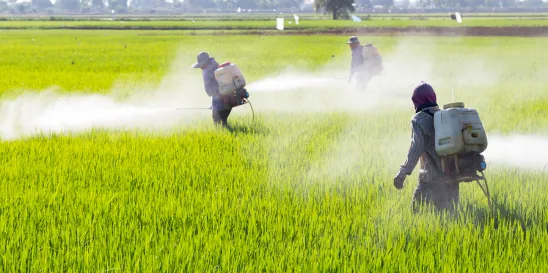On November 2, 2023, the Eighth Circuit Court of Appeals (Eighth Circuit) issued its decision in Red River Valley Sugarbeet Growers Ass’n v. Regan, No. 22-1422 (8th Cir. 2023) regarding the use of the pesticide chlorpyrifos on food crops (Decision). The court concluded that the U.S. Environmental Protection Agency’s (EPA) August 2021 revocation of all food tolerances for chlorpyrifos was arbitrary and capricious, and remanded the matter back to EPA for further review.
Chlorpyrifos was a widely used organophosphate insecticide and has been the target of activist group attention and controversy over many years. In 2007, the Pesticide Action Network North America (PANNA) and the Natural Resources Defense Council (NRDC) filed a petition to revoke the tolerances and cancel the registrations for chlorpyrifos. After many rounds of legal wrangling, the Ninth Circuit’s decision in League of United Latin Am. Citizens v. Regan, 996 F.3d 673 (9th Cir. 2021) ordered EPA, within 60 days, to either revoke all chlorpyrifos tolerances or modify the tolerances if EPA could certify that the tolerances as modified were safe.
On August 30, 2021, in compliance with the Ninth Circuit ruling, EPA issued a final rule revoking all tolerances for chlorpyrifos (2021 Revocation). 86 Fed. Reg. 48315. The tolerances for chlorpyrifos were revoked on February 28, 2022, six months after the final rule was published in the Federal Register (2022 Denial Order). 87 Fed. Reg. 11222, 11246. Without any specified food tolerances for chlorpyrifos, it could not be used on crops intended for food production.
Following EPA’s revocation, several farm groups sued EPA, challenging its decision and asking the court to reinstate the tolerances. The Eighth Circuit’s Decision grants that request by vacating EPA’s 2021 Revocation and 2022 Denial Order and remanding the case to EPA for further proceedings.
In vacating EPA’s revocation of all tolerances, the Eighth Circuit noted EPA’s arguments that the urgency and short deadline set forth by the Ninth Circuit for a final chlorpyrifos decision did not allow sufficient time for consideration of potential labeled uses that could meet the safety standard. The Eighth Circuit held, however, that EPA “fail[ed] to consider [an] important aspect of [a] problem” because it misunderstands “the full scope of [its] discretion.” Decision at 8. Specifically, the court states “a short deadline is no excuse for zeroing in on a single solution to the exclusion of others.” Decision at 14.
Instead, the court found that EPA has a duty to “anticipate” the “aggregate exposure” based on its own proposal and could not justify its decision to revoke all tolerances based on the fact that the pesticide registrants and the public had not prioritized the various tolerances and uses that could be revoked or remain. On remand, EPA “remains free to exercise its discretion as long as it considers all ‘important aspect[s] of the problem’ and gives a reasoned explanation for whichever option it chooses.” Decision at 15.
EPA has 45 days from the date of the ruling to decide how it will proceed, including whether it will seek a rehearing by the Eighth Circuit’s full panel of judges. EPA states it is reviewing the Decision but has not yet commented on its next steps.
Commentary
Perhaps the most unusual element of EPA’s 2021 chlorpyrifos decision was EPA’s revocation of all food tolerances for the pesticide, even when EPA had determined that some of the many uses nonetheless met the required safety standard. The determination of safety included the required “extra 10x safety factor” to ensure protection of children along with the many standard conservative risk assessment assumptions. EPA’s revocation assessment also reviewed epidemiology studies, including the pivotal “Columbia studies” (i.e., studies conducted at the Columbia Center for Children’s Environmental Health (CCCEH)) that many stakeholders cited as the major evidence of harm from the use of chlorpyrifos.
The Eighth Circuit Decision relies especially on the EPA conclusion that some of the chlorpyrifos uses met the regulatory standards used by EPA, even as it explained the 2021 final rule to revoke all tolerances. The Decision reviews, but rejects, EPA’s rationale for its decision based on the urgency it faced following an extensive litigation trial where the Ninth Circuit had stressed that it had no further patience for EPA’s delays in making final decisions.
Now that the Eighth Circuit has vacated EPA’s final rule, the matter has been remanded to EPA, where, the court states, “more than just modification is on the table.” In prior situations, when all was said and done following EPA’s regulatory decisions, any registrant rebuttals, additional data, or general advocacy, and EPA had decided that some or nearly all of the current registrations had to be removed from use, the registrant was allowed to eliminate uses so that any remaining uses could “fit in the risk cup.” This Decision would seem to allow, if not require, EPA to consider registrant requests to tailor a registration for remaining uses that meet the food safety standard or at least make its own determinations regarding uses that it can determine meet, or no longer meet, the required standards.




 />i
/>i
